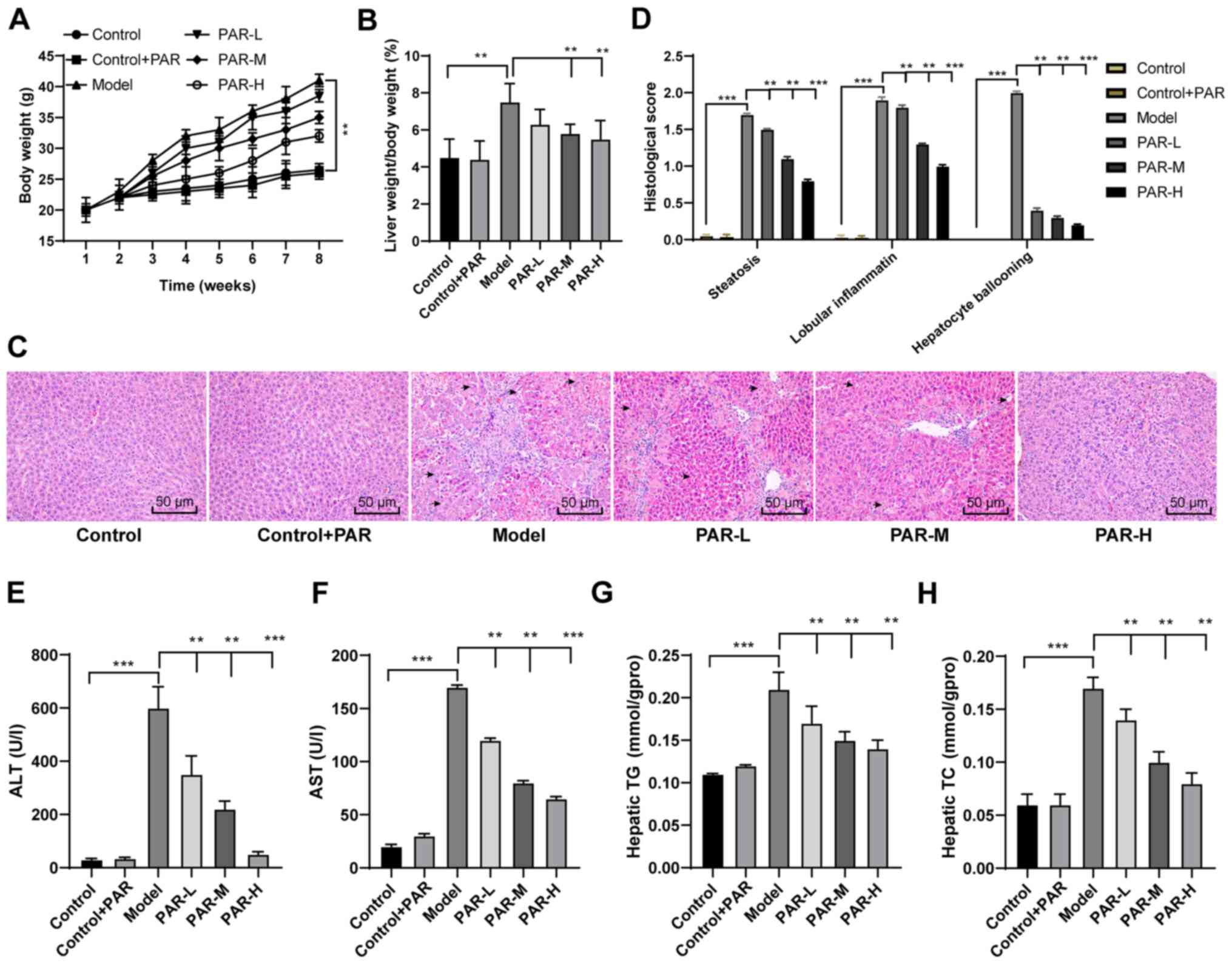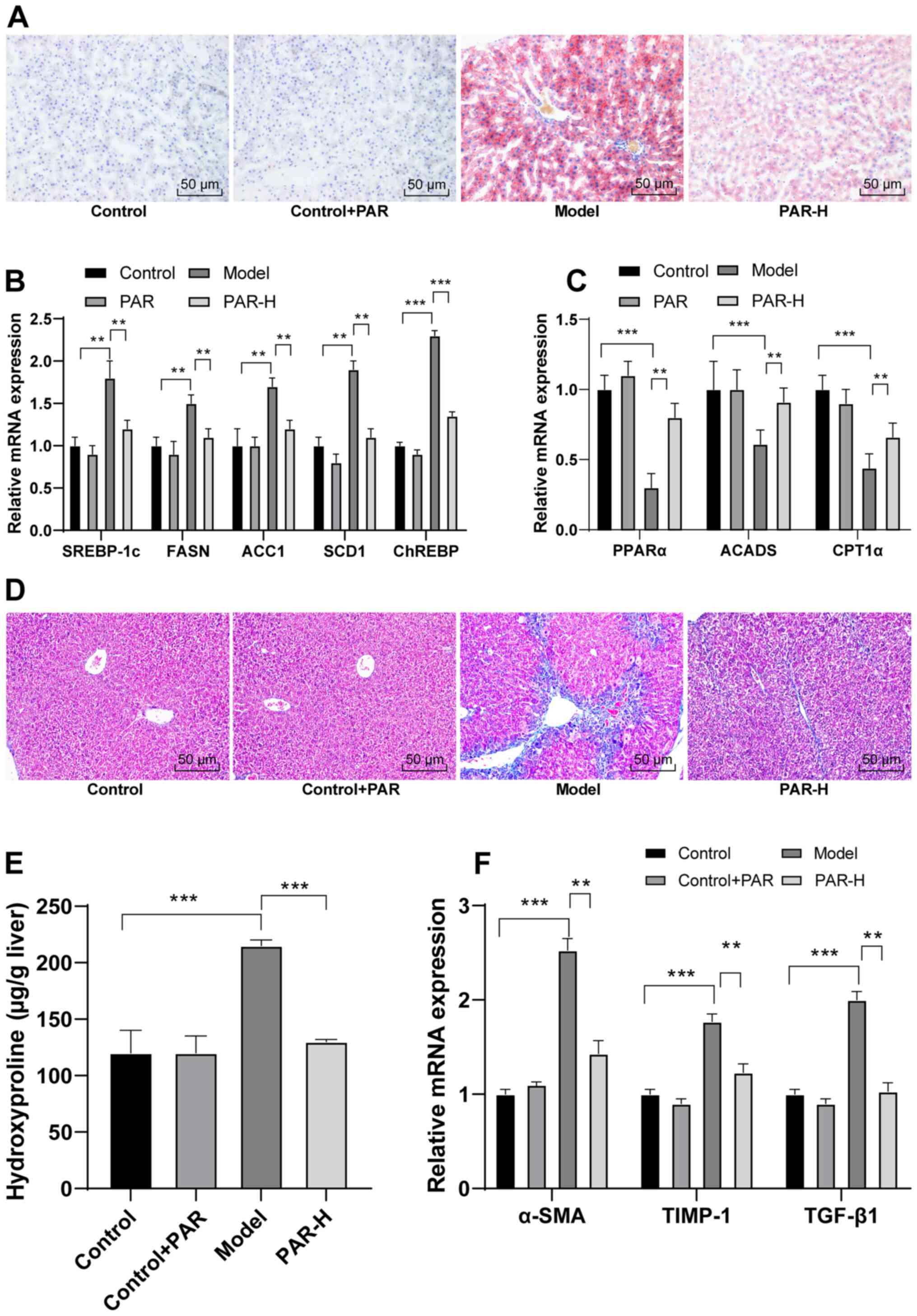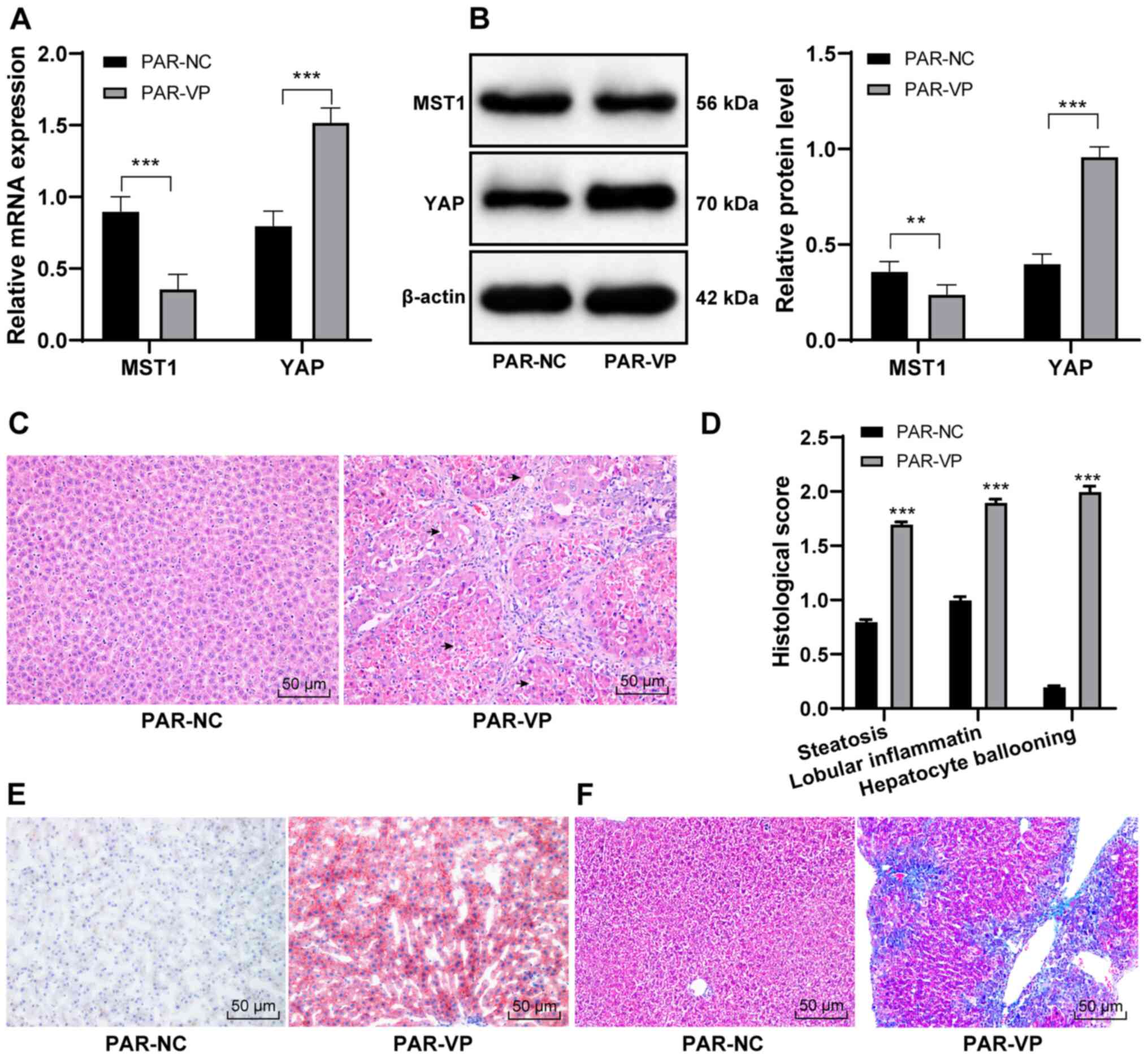|
1
|
Tilg H and Effenberger M: From NAFLD to
MAFLD: When pathophysiology succeeds. Nat Rev Gastroenterol
Hepatol. 17:387–388. 2020. View Article : Google Scholar : PubMed/NCBI
|
|
2
|
Farzanegi P, Dana A, Ebrahimpoor Z, Asadi
M and Azarbayjani MA: Mechanisms of beneficial effects of exercise
training on non-alcoholic fatty liver disease (NAFLD): Roles of
oxidative stress and inflammation. Eur J Sport Sci. 19:994–1003.
2019. View Article : Google Scholar : PubMed/NCBI
|
|
3
|
Eslam M, Newsome PN, Sarin SK, Anstee QM,
Targher G, Romero-Gomez M, Zelber-Sagi S, Wai-Sun Wong V, Dufour
JF, Schattenberg JM, et al: A new definition for metabolic
dysfunction-associated fatty liver disease: An international expert
consensus statement. J Hepatol. 73:202–209. 2020. View Article : Google Scholar : PubMed/NCBI
|
|
4
|
Eslam M and George J: Reply to:
Correspondence on ‘A new definition for metabolic associated fatty
liver disease: An international expert consensus statement’: MAFLD:
Moving from a concept to practice. J Hepatol. 73:1268–1269. 2020.
View Article : Google Scholar : PubMed/NCBI
|
|
5
|
Eslam M, Valenti L and Romeo S: Genetics
and epigenetics of NAFLD and NASH: Clinical impact. J Hepatol.
68:268–279. 2018. View Article : Google Scholar : PubMed/NCBI
|
|
6
|
Jegatheesan P and De Bandt JP: Fructose
and NAFLD: The multifaceted aspects of fructose metabolism.
Nutrients. 9:2302017. View Article : Google Scholar : PubMed/NCBI
|
|
7
|
Bellentani S: The epidemiology of
non-alcoholic fatty liver disease. Liver Int. 37 (Suppl 1):81–84.
2017. View Article : Google Scholar : PubMed/NCBI
|
|
8
|
Rotman Y and Sanyal AJ: Current and
upcoming pharmacotherapy for non-alcoholic fatty liver disease.
Gut. 66:180–190. 2017. View Article : Google Scholar : PubMed/NCBI
|
|
9
|
Van De Wier B, Koek GH, Bast A and Haenen
GR: The potential of flavonoids in the treatment of non-alcoholic
fatty liver disease. Crit Rev Food Sci Nutr. 57:834–855. 2017.
View Article : Google Scholar : PubMed/NCBI
|
|
10
|
Liu C, Liao JZ and Li PY: Traditional
Chinese herbal extracts inducing autophagy as a novel approach in
therapy of nonalcoholic fatty liver disease. World J Gastroenterol.
23:1964–1973. 2017. View Article : Google Scholar : PubMed/NCBI
|
|
11
|
Duan D, Zhang J, Yao J, Liu Y and Fang J:
Targeting thioredoxin reductase by parthenolide contributes to
inducing apoptosis of HeLa cells. J Biol Chem. 291:10021–10031.
2016. View Article : Google Scholar : PubMed/NCBI
|
|
12
|
Wang D, Wang H, Fu S, Cheng X, Yang F,
Zhang Q, Li Y, Xue Z, Zhang L, Huang W, et al: Parthenolide
ameliorates Concanavalin A-induced acute hepatitis in mice and
modulates the macrophages to an anti-inflammatory state. Int
Immunopharmacol. 38:132–138. 2016. View Article : Google Scholar : PubMed/NCBI
|
|
13
|
Barbier-Torres L, Beraza N,
Fernández-Tussy P, Lopitz-Otsoa F, Fernández-Ramos D,
Zubiete-Franco I, Varela-Rey M, Delgado TC, Gutiérrez V, Anguita J,
et al: Histone deacetylase 4 promotes cholestatic liver injury in
the absence of prohibitin-1. Hepatology. 62:1237–1248. 2015.
View Article : Google Scholar : PubMed/NCBI
|
|
14
|
Bahabadi M, Mohammadalipour A, Karimi J,
Sheikh N, Solgi G, Goudarzi F, Hashemnia M and Khodadadi I:
Hepatoprotective effect of parthenolide in rat model of
nonalcoholic fatty liver disease. Immunopharmacol Immunotoxicol.
39:233–242. 2017. View Article : Google Scholar : PubMed/NCBI
|
|
15
|
Patel SH, Camargo FD and Yimlamai D: Hippo
signaling in the liver regulates organ size, cell fate, and
carcinogenesis. Gastroenterology. 152:533–545. 2017. View Article : Google Scholar : PubMed/NCBI
|
|
16
|
Zhou Y, Lv X, Qu H, Zhao K, Fu L, Zhu L,
Ye G and Guo J: Differential expression of circular RNAs in hepatic
tissue in a model of liver fibrosis and functional analysis of
their target genes. Hepatol Res. 49:324–334. 2019. View Article : Google Scholar : PubMed/NCBI
|
|
17
|
Fujisawa K, Takami T, Sasai N, Matsumoto
T, Yamamoto N and Sakaida I: Metabolic alterations in
spheroid-cultured hepatic stellate cells. Int J Mol Sci.
21:34512020. View Article : Google Scholar : PubMed/NCBI
|
|
18
|
Yi M, Li J, Chen S, Cai J, Ban Y, Peng Q,
Zhou Y, Zeng Z, Peng S, Li X, et al: Correction to: Emerging role
of lipid metabolism alterations in Cancer stem cells. J Exp Clin
Cancer Res. 37:1552018. View Article : Google Scholar : PubMed/NCBI
|
|
19
|
Kodama T, Yi J, Newberg JY, Tien JC, Wu H,
Finegold MJ, Kodama M, Wei Z, Tamura T, Takehara T, et al:
Molecular profiling of nonalcoholic fatty liver disease-associated
hepatocellular carcinoma using SB transposon mutagenesis. Proc Natl
Acad Sci USA. 115:E10417–E10426. 2018. View Article : Google Scholar : PubMed/NCBI
|
|
20
|
Lopez-Franco O, Hernández-Vargas P,
Ortiz-Muñoz G, Sanjuán G, Suzuki Y, Ortega L, Blanco J, Egido J and
Gómez-Guerrero C: Parthenolide modulates the NF-kappaB-mediated
inflammatory responses in experimental atherosclerosis.
Arterioscler Thromb Vasc Biol. 26:1864–1870. 2006. View Article : Google Scholar : PubMed/NCBI
|
|
21
|
Kim SL, Liu YC, Seo SY, Kim SH, Kim IH,
Lee SO, Lee ST, Kim DG and Kim SW: Parthenolide induces apoptosis
in colitis-associated colon cancer, inhibiting NF-κB signaling.
Oncol Lett. 9:2135–2142. 2015. View Article : Google Scholar : PubMed/NCBI
|
|
22
|
Kleiner DE, Brunt EM, Van Natta M, Behling
C, Contos MJ, Cummings OW, Ferrell LD, Liu YC, Torbenson MS,
Unalp-Arida A, et al: Design and validation of a histological
scoring system for nonalcoholic fatty liver disease. Hepatology.
41:1313–1321. 2005. View Article : Google Scholar : PubMed/NCBI
|
|
23
|
Livak KJ and Schmittgen TD: Analysis of
relative gene expression data using real-time quantitative PCR and
the 2(-Delta Delta C(T)) method. Methods. 25:402–408. 2001.
View Article : Google Scholar : PubMed/NCBI
|
|
24
|
Wang M and Li Q: Parthenolide could become
a promising and stable drug with anti-inflammatory effects. Nat
Prod Res. 29:1092–1101. 2015. View Article : Google Scholar : PubMed/NCBI
|
|
25
|
Liao K, Xia B, Zhuang QY, Hou MJ, Zhang
YJ, Luo B, Qiu Y, Gao YF, Li XJ, Chen HF, et al: Parthenolide
inhibits cancer stem-like side population of nasopharyngeal
carcinoma cells via suppression of the NF-κB/COX-2 pathway.
Theranostics. 5:302–321. 2015. View Article : Google Scholar : PubMed/NCBI
|
|
26
|
Li XH, Xiao T, Yang JH, Qin Y, Gao JJ, Liu
HJ and Zhou HG: Parthenolide attenuated bleomycin-induced pulmonary
fibrosis via the NF-κB/Snail signaling pathway. Respir Res.
19:1112018. View Article : Google Scholar : PubMed/NCBI
|
|
27
|
Machado MV, Michelotti GA, Pereira TA, Xie
G, Premont R, Cortez-Pinto H and Diehl AM: Accumulation of duct
cells with activated YAP parallels fibrosis progression in
non-alcoholic fatty liver disease. J Hepatol. 63:962–970. 2015.
View Article : Google Scholar : PubMed/NCBI
|
|
28
|
Chen P, Luo Q, Huang C, Gao Q, Li L, Chen
J, Chen B, Liu W, Zeng W and Chen Z: Pathogenesis of non-alcoholic
fatty liver disease mediated by YAP. Hepatol Int. 12:26–36. 2018.
View Article : Google Scholar : PubMed/NCBI
|
|
29
|
Younossi Z, Anstee QM, Marietti M, Hardy
T, Henry L, Eslam M, George J and Bugianesi E: Global burden of
NAFLD and NASH: Trends, predictions, risk factors and prevention.
Nat Rev Gastroenterol Hepatol. 15:11–20. 2018. View Article : Google Scholar : PubMed/NCBI
|
|
30
|
Berdan CA, Ho R, Lehtola HS, To M, Hu X,
Huffman TR, Petri Y, Altobelli CR, Demeulenaere SG, Olzmann JA, et
al: Parthenolide covalently targets and inhibits focal adhesion
kinase in breast cancer cells. Cell Chem Biol. 26:1027–1035 e22.
2019. View Article : Google Scholar : PubMed/NCBI
|
|
31
|
Wu CT, Deng JS, Huang WC, Shieh PC, Chung
MI and Huang GJ: Salvianolic acid C against acetaminophen-induced
acute liver injury by attenuating inflammation, oxidative stress,
and apoptosis through inhibition of the Keap1/Nrf2/HO-1 signaling.
Oxid Med Cell Longev. 2019:90568452019. View Article : Google Scholar : PubMed/NCBI
|
|
32
|
Xia SF, Shao J, Zhao SY, Qiu YY, Teng LP,
Huang W, Wang SS, Cheng XR and Jiang YY: Niga-ichigoside F1
ameliorates high-fat diet-induced hepatic steatosis in male mice by
Nrf2 activation. Food Funct. 9:906–916. 2018. View Article : Google Scholar : PubMed/NCBI
|
|
33
|
Rui L: Energy metabolism in the liver.
Compr Physiol. 4:177–197. 2014. View Article : Google Scholar : PubMed/NCBI
|
|
34
|
Makled MN, Sharawy MH and El-Awady MS: The
dual PPAR-α/γ agonist saroglitazar ameliorates
thioacetamide-induced liver fibrosis in rats through regulating
leptin. Naunyn Schmiedebergs Arch Pharmacol. 392:1569–1576. 2019.
View Article : Google Scholar : PubMed/NCBI
|
|
35
|
Zhang Y, Miao H, Guan H, Wang C, Wang Z
and Ji L: Long-term diosbulbin B treatment induced liver fibrosis
in mice. Chem Biol Interact. 298:15–23. 2019. View Article : Google Scholar : PubMed/NCBI
|
|
36
|
Li S, Gao X, Wu X, Wu Z, Cheng L, Zhu L,
Shen D and Tong X: Parthenolide inhibits LPS-induced inflammatory
cytokines through the toll-like receptor 4 signal pathway in THP-1
cells. Acta Biochim Biophys Sin (Shanghai). 47:368–375. 2015.
View Article : Google Scholar : PubMed/NCBI
|
|
37
|
Paolucci EM, Loukov D, Bowdish DME and
Heisz JJ: Exercise reduces depression and inflammation but
intensity matters. Biol Psychol. 133:79–84. 2018. View Article : Google Scholar : PubMed/NCBI
|
|
38
|
Min YN, Niu ZY, Sun TT, Wang ZP, Jiao PX,
Zi BB, Chen PP, Tian DL and Liu FZ: Vitamin E and vitamin C
supplementation improves antioxidant status and immune function in
oxidative-stressed breeder roosters by up-regulating expression of
GSH-Px gene. Poult Sci. 97:1238–1244. 2018. View Article : Google Scholar : PubMed/NCBI
|
|
39
|
Kim CY, Jung YW and Park JS: Parthenolide,
a feverfew-derived phytochemical, ameliorates obesity and
obesity-induced inflammatory responses via the Nrf2/Keap1 pathway.
Pharmacol Res. 145:1042592019. View Article : Google Scholar : PubMed/NCBI
|
|
40
|
Ardestani A, Lupse B and Maedler K: Hippo
signaling: Key emerging pathway in cellular and whole-body
metabolism. Trends Endocrinol Metab. 29:492–509. 2018. View Article : Google Scholar : PubMed/NCBI
|
|
41
|
Johnson RL: Hippo signaling and epithelial
cell plasticity in mammalian liver development, homeostasis, injury
and disease. Sci China Life Sci. 62:1609–1616. 2019. View Article : Google Scholar : PubMed/NCBI
|
|
42
|
Jeong SH, Kim HB, Kim MC, Lee JM, Lee JH,
Kim JH, Kim JW, Park WY, Kim SY, Kim JB, et al: Hippo-mediated
suppression of IRS2/AKT signaling prevents hepatic steatosis and
liver cancer. J Clin Invest. 128:1010–1025. 2018. View Article : Google Scholar : PubMed/NCBI
|



















